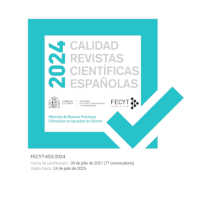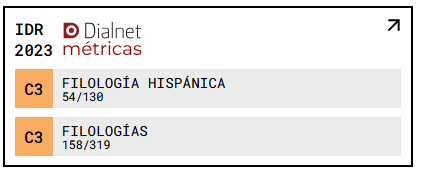Existential Mists and Transtextuality in Murakami's "The City and Its Uncertain Walls"
DOI:
https://doi.org/10.18172/cif.6425Keywords:
Contemporary Narrative, Haruki Murakami, Japanese Literature, Fantastic Realism, Japanese NovelistsAbstract
The novel The City and Its Uncertain Walls (2023) by Haruki Murakami can be analyzed from a textual perspective (genesis, textual precedents) as well as a structural one, paying attention to the narrative pieces that compose it and their relevant marks, especially thematic ones. It is essential to consider the aspects of fantastic realism present, a literary orientation especially suited to recognize the literary tone of its author. Attention has been paid to the recurring elements in Murakami and to the possible novel contributions of this novel. The consultation of the works of specialists of the relevance of Seats, Strecher, Rubin, Rubio and Sotelo has provided the necessary theoretical contribution for the analysis.
Downloads
References
CASTELLÓN ALCALÁ, H. (2024). “Modelos de argumentos en la narrativa de Murakami”. Anuario de Estudios Filológicos, 47, 69-91. https://doi.org/10.17398/2660-7301.47.69 DOI: https://doi.org/10.17398/2660-7301.47.69
GENETTE, G. (1982). Palimpsestes. La littérature au second degré. París, Seuil.
HARDING, J. W. (1994). “Haruki Murakami.” BOMB. #46 January 1. Citado en Morales. https://bombmagazine.org/articles/1994/01/01/haruki-murakami/
LÓPEZ JARA, S. (2020). “La estructura informativa española y japonesa: problemas con el tema y el foco en la enseñanza del español a japoneses”. En Perfiles, factores y contextos en la enseñanza y el aprendizaje de ELE/EL2. Universidade de Santiago de Compostela, pp. 609-623. https://cvc.cervantes.es/ensenanza/biblioteca_ele/asele/pdf/29/29_0043.pdf
MORALES, D. (2023). “Review of Haruki Murakami’s 街とその不確かな壁 (The City and Its Uncertain Walls)”. Medium 29 junio. https://medium.com/@howtojapanese/review-of-haruki-murakamis-街とその不確かな壁-the-city-and-its-uncertain-walls-2023-c1ea552d148c
MURAKAMI, H. (1990). “Telling the Story of my Works”, Murakami Haruki Complete Works 1979–1989 Vol. 4, Kodansha, 1990. Trad. del japonés Daniel Morales. Citado en Morales.
MURAKAMI, H. (2024). La ciudad y sus muros inciertos. Trad. Juan Francisco González Sánchez. Barcelona. Tusquets.
PRADO FONTS, C. (2013). “Bases de la cultura y el pensamiento de China y Japón”. Pensamiento, septiembre. Universitat Oberta de Cataluña. https://openaccess.uoc.edu/bitstream/10609/78832/1/Bases%20de%20la%20cultura%20y%20el%20pensamiento%20de%20China%20y%20Jap%C3%B3n_M%C3%B3dulo%201_Pensamiento.pdf
ROAS, D. (2009). “Lo fantástico como desestabilización de lo real: elementos para una definición”. En T. López Pellisa y F. A. Moreno Serrano (Eds.), Ensayos sobre ciencia ficción y literatura fantástica: actas del Primer Congreso Internacional de literatura fantástica y ciencia ficción. Asociación Cultural Xatafi. Universidad Carlos III de Madrid, 94-120. http://hdl.handle.net/10016/8584
RUBIN, J. (2002). Haruki Murakami and the music of words. London, The Harvill Press.
RUBIO, C. (2012). El Japón de Murakami. Madrid, Aguilar.
SEATS, R. M. (2002). Murakami Haruki: The Simulacrum in Contemporary Japanese Culture. Tesis doctoral Universidad de Murdoch. https://researchportal.murdoch.edu.au/esploro/outputs/doctoral/Murakami-Haruki-The-simulacrum-in-contemporary/991005542134007891
SOTELO, J. (2013). Los mundos de Murakami. Madrid, Izana Editores.
STRECHER, M. C. (2014). The Forbidden Worlds of Haruki Murakami. Minneapolis-London, University of Minnesota Press. DOI: https://doi.org/10.5749/minnesota/9780816691968.001.0001
YUKAWA, Y. y T. KOYAMA. (2023). “Novelist Haruki Murakami speaks of fully pursuing motifs in latest novel”. Kyodo News, 15 noviembre.
YŪSAKU, T. (2023). “«La ciudad y sus muros inciertos»: Murakami Haruki regresa al escenario de una vieja historia”. Literatura Cultura 24 mayo. https://www.nippon.com/es/japan-topics/bg900467/
Downloads
Published
How to Cite
Issue
Section
License
Copyright (c) 2024 Heraclia Castellón Alcalá

This work is licensed under a Creative Commons Attribution 4.0 International License.
The authors retain copyright of articles and authorize CIF the first publication. They are free to share and redistribute the article without obtaining permission from the publisher as long as they give appropriate credit to the editor and the journal.
Self-archiving is allowed too. In fact, it is recommendable to deposit a PDF version of the paper in academic and/or institutional repositories.
It is recommended to include the DOI number.
This journal is licensed under a Creative Commons Attribution 4.0 International License














